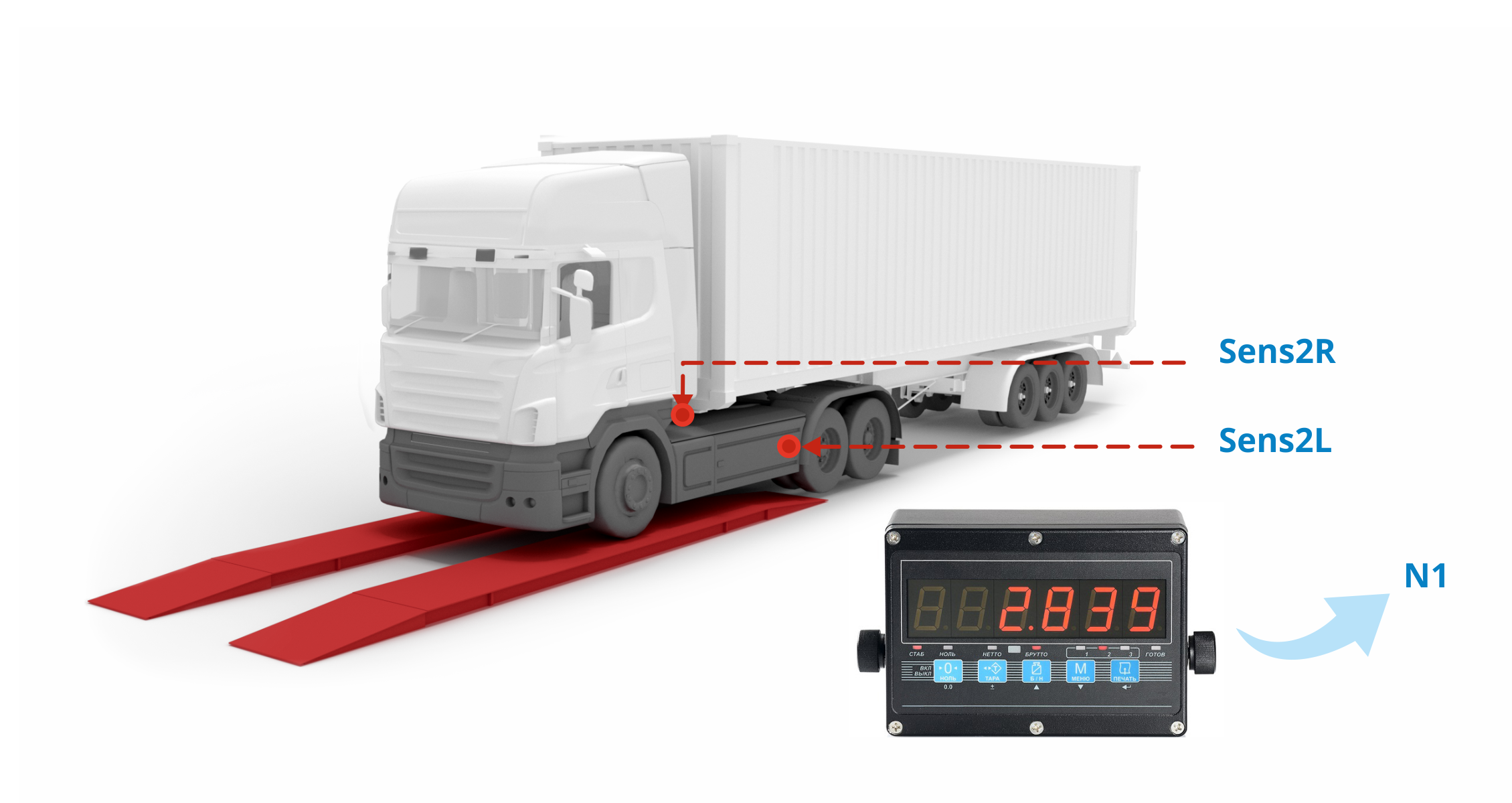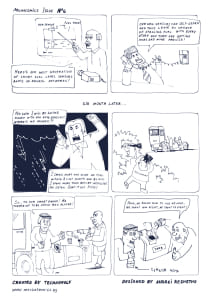After installing the axle load sensors, it is required to calibrate them. Calibration requires a vehicle platform scale or a weighing pads for individual wheel weighing.
Lets consider the example:
The truck vehicle is equipped with 2 Eurosens DPS pressure sensors (one each in the left and right air suspension circuits). Also, two Eurosens DPS pressure sensor is installed in the left and right air suspension circuits of the trailer.
We need to measure the actual axial loads on all axles.
We drive the front axle of the tractor onto the scales and measure the load on the front axle N1 (kg). We write the output value of the sensor of the left circuit Sens1L and the sensor of the right circuit Sens1R.
2. Next, we measure the paired axles of the tractor. We cannot place only one of these axles on the scale due to the dimensions of the scale and the vehicle. Therefore, we measure the total load N2 on the paired axles. Due to the impossibility of measuring the individual load on each of the paired axles using platform scales, we will assume that they are the same.
3. Next, we measure the axles of the trailer. Again we cannot place only one of these axles on the scale. Due to the impossibility of measuring the individual load on each of the axles using a platform scale, we will assume that they are the same. Measure total weight N3.
We record the output value of the sensor of the left circuit of the trailer Sens3L and the sensor of the right circuit of the trailer Sens3R.
Now we create sensors in the GPS tracking software and add the first points to their calibration tables.
Axle 1 (left side): input value Sens1L; output value N1
Axle 1 (right side): Sens1R; N1
Since we separately measure the value of the load on the left and right sides the axle load is considered as the average of the load values .
Load_axle1=(Axle 1 (left side) + Axle 1 (right side))/2
For axles 2 and 3, the actual measured load is divided by 2, equally for each of the axles.
Axle 2 (left side): Sens2L; N2/2
Axis 2 (right side): Sens2R; N2/2
Axis 3 (left side): Sens2L; N2/2
Axis 3 (right side): Sens2R; N2/2
Load_axle2=(Axle 2(left side) + Axle 2(right side))/2
Load_axle3=(Axle 3(left side + Axle 3(right side))/2
And same for trailer:
Axis_t_1 (left side) : Sens3L; N3/3
Axis_t_1 (right side): Sens3R; N3/3
Axis_t_2 (left side) : Sens3L; N3/3
Axis_t_2 (right side): Sens3R; N3/3
Axis_t_3 (left side) : Sens3L; N3/3
Axis_t_3 (right side): Sens3R; N3/3
Axis_trailer_1=( Axis_t_1 (left side) + Axis_t_1 (right side) )/2
Axis_trailer_2=( Axis_t_2 (left side) + Axis_t_2 (right side))/2
Axis_trailer_3=( Axis_t_3 (left side) + Axis_t_3 (right side))/2
To create a calibration table for each of the sensors, at least one more point is required. While the first measurement is usually taken in the “Empty” state, when there is no load in the vehicle or trailer, the second mandatory calibration point is the loaded state. The closer the load is to full, the better.
If during operation the vehicle will drive on the scales and make similar measurements, then additional calibration points can improve the accuracy of the axle load measurement.
Calibration tables for calculating axial loads can be programmed either on the server side (for example, in the sensor properties in Wialon) or directly into the sensor.
Calibration on the server side is convenient because it does not require direct wired connection to the sensor. This means that it can be done remotely. The output values of the sensors (SENS values above) are visible as a GPS tracking data, all we need for calibration is to measure the actual axial loads N using a scales as shown above.
Thus, the vehicle can be calibrated in the course of carrying out normal activities.
The sensor-side calibration method is used if the on-board equipment includes an on-board display, such as eurosens Display CAN. In this case, the value of axle loads in tons must be calculated directly onboard.
To record calibration onboard we have to :
- carry out several measurements of axial loads using scales;
- be connected to the sensor at the time of measurement;
- enter the current value of the scales in the field “Load, kg”;
- add a new line to the calibration table with each measurement by pressing the “Calibrate” button.
After that, the current value of the detector is entered into the table along with the measured axial load. The table can be filled in several steps, saving intermediate results to the sensor.
Features of the use of platform scales with a long platform.
Platform scales that can weigh an entire truck-trailer combo are a little more difficult to use for calibration. Measuring the load on the front axle will not cause problems – we can, as before, drive onto the scales only with the front axle. To measure the axle loads on the remaining axles of the tractor, we will have to weigh the entire vehicle.
And then subtract the axle load on the front axle. And then measure the axle loads on the trailer axles
For calibration, it is desirable to use platform scales installed at the same level with the road. High ramp will increase an error in the measurement of axial loads when the car partially enters the scales
Above – an undesirable design of the scales, below – the scales, made on the same level with the road.























We are in social media
Facebook
LinkedIn
Youtube